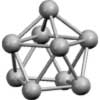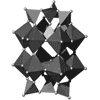Solid State Chemistry and Materials Chemistry are destined to play a crucial role in the next decades through the synthesis of new materials with fundamentally different structures and potential for novel properties. Our research efforts are with a strong emphasis on the synthesis and characterization of such solid-state compounds, and are aimed along these major directions:
 The first one is to study the chemistry of the post-transition elements at their negative oxidation states (polar itermetallic compounds).
This interest has grown out of the synthetic work in a new class of clusters of group 14, and networks of heteroatomic clusters of groups 12 and 14 or groups 13 and 15.
Unprecedented naked clusters of Si94-, Ge94-, and Pb94- (monocapped square antiprisms or tricapped trigonal prisms), Sn86- (square antiprism) and [Ge8Zn]6- (two trigonal bipyramids sharing a vertex of Zn) were found in the solid-state compounds Rb12Si17, Cs4Ge9, Cs4Pb9, Rb4Li2Sn8 and Cs6Ge8Zn, respectively.
These are only a few examples of the potentially rich field of intermetallic Zintl compounds, and our goal is to synthetically explore them, investigate their crystal and electronic structures, and study their physical properties.
Furthermore, of great interest is the possibility to bring such metal clusters into solution, and explore their reactivity towards a variety of ligands. We are interested in making semiconducting thin films and single-size nanoparticles from the dissolved clusters.
Such particles exhibit size-dependent band gaps and large nonlinear optical effects that may lead to the next generation of optical devices.
The first one is to study the chemistry of the post-transition elements at their negative oxidation states (polar itermetallic compounds).
This interest has grown out of the synthetic work in a new class of clusters of group 14, and networks of heteroatomic clusters of groups 12 and 14 or groups 13 and 15.
Unprecedented naked clusters of Si94-, Ge94-, and Pb94- (monocapped square antiprisms or tricapped trigonal prisms), Sn86- (square antiprism) and [Ge8Zn]6- (two trigonal bipyramids sharing a vertex of Zn) were found in the solid-state compounds Rb12Si17, Cs4Ge9, Cs4Pb9, Rb4Li2Sn8 and Cs6Ge8Zn, respectively.
These are only a few examples of the potentially rich field of intermetallic Zintl compounds, and our goal is to synthetically explore them, investigate their crystal and electronic structures, and study their physical properties.
Furthermore, of great interest is the possibility to bring such metal clusters into solution, and explore their reactivity towards a variety of ligands. We are interested in making semiconducting thin films and single-size nanoparticles from the dissolved clusters.
Such particles exhibit size-dependent band gaps and large nonlinear optical effects that may lead to the next generation of optical devices.
 The second research area deals with hydrothermal exploratory synthesis of hybrid organic-inorganic materials with framework structures.
We are interested in systems which have potential for microporosity and other useful properties at the same time.
One such system is transition-metal boro-phosphates.
It is analogous to the well known microporous alumophosphates, and at the same time has the potential for non-linear or "chiral" properties due to possible trigonal-planar BO33- units, or redox catalytic activity due to the transition metal involved. We have synthesized the first such microporous cobalt borophosphate, CoB2P3O12(OH)•en, with ethylenediamine (en) as the organic templates.
Other systems include transition metals combined with organic species with two or more functional groups such as di-phosphonates,carboxylate-phosphonates, boronate-phosphonates, carboxylate-boronates, etc.
The second research area deals with hydrothermal exploratory synthesis of hybrid organic-inorganic materials with framework structures.
We are interested in systems which have potential for microporosity and other useful properties at the same time.
One such system is transition-metal boro-phosphates.
It is analogous to the well known microporous alumophosphates, and at the same time has the potential for non-linear or "chiral" properties due to possible trigonal-planar BO33- units, or redox catalytic activity due to the transition metal involved. We have synthesized the first such microporous cobalt borophosphate, CoB2P3O12(OH)•en, with ethylenediamine (en) as the organic templates.
Other systems include transition metals combined with organic species with two or more functional groups such as di-phosphonates,carboxylate-phosphonates, boronate-phosphonates, carboxylate-boronates, etc.
***
Characterization of the new compounds involves powder and single crystal X-ray diffraction, IR and UV-VIS spectroscopies, thermogravimetry, and measurements of magnetism and electrical conductivity. In addition, theoretical calculations are performed in order to elucidate the electronic structures of the compounds and to explain their physical properties.